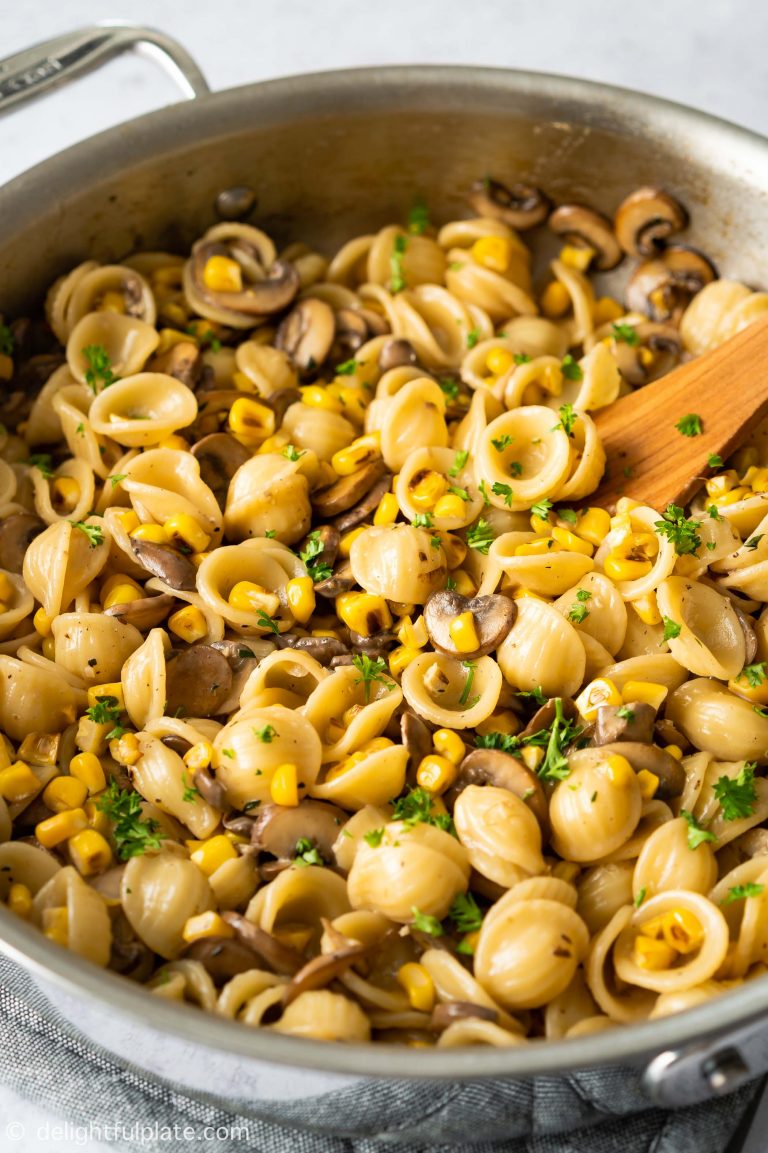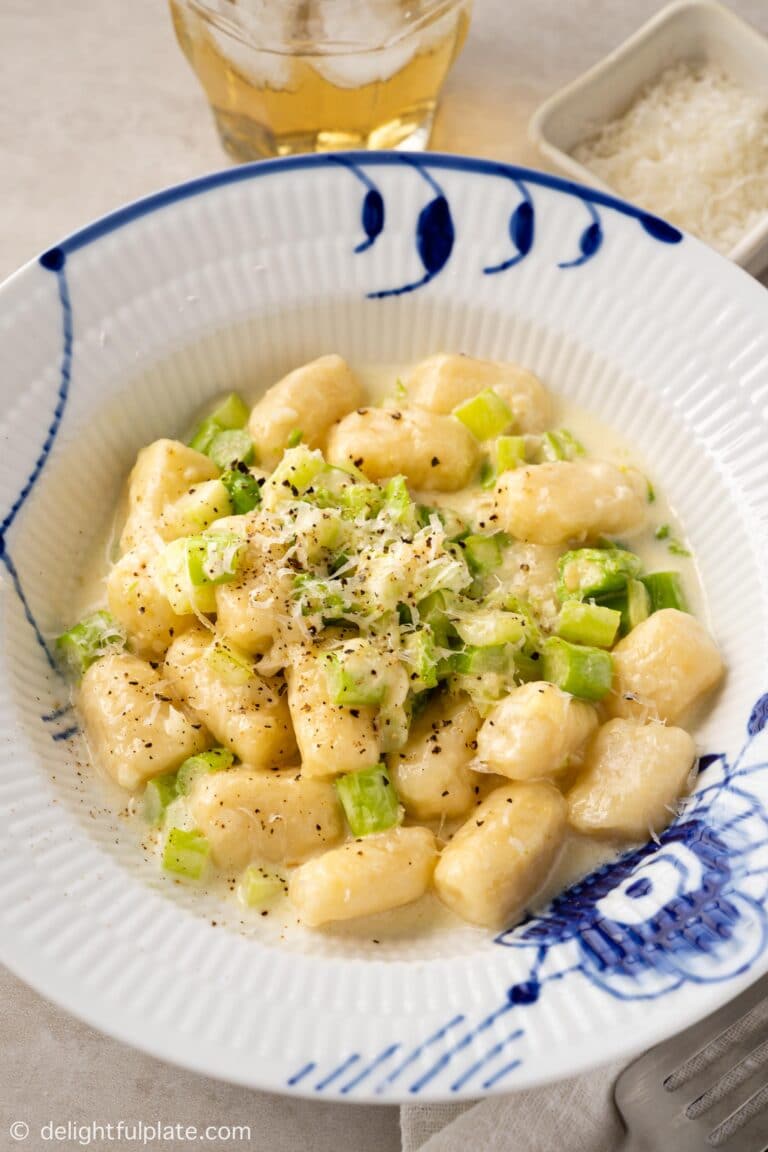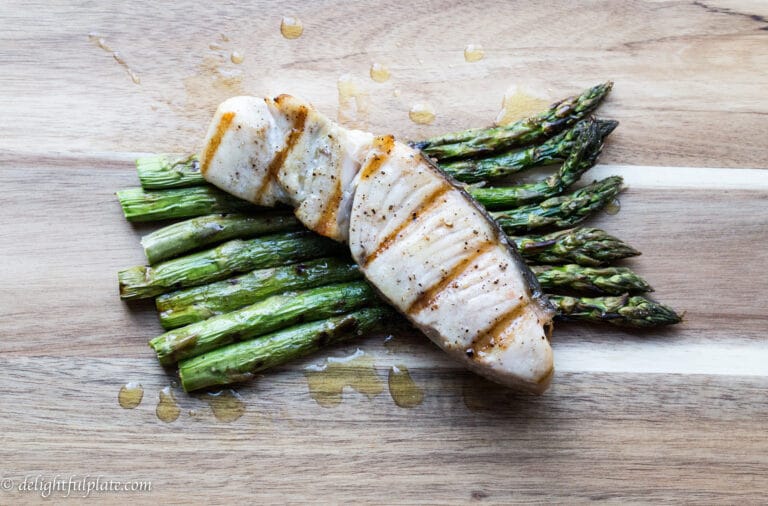Mì Quảng (Vietnamese Quang-style Noodle)
Mì Quảng is a signature rice noodle dish of Quang Nam province in the Central region of Vietnam. It features slippery noodles, colorful toppings, and flavorful broth. If you are ready for something new beyond phở, definitely give it a try.
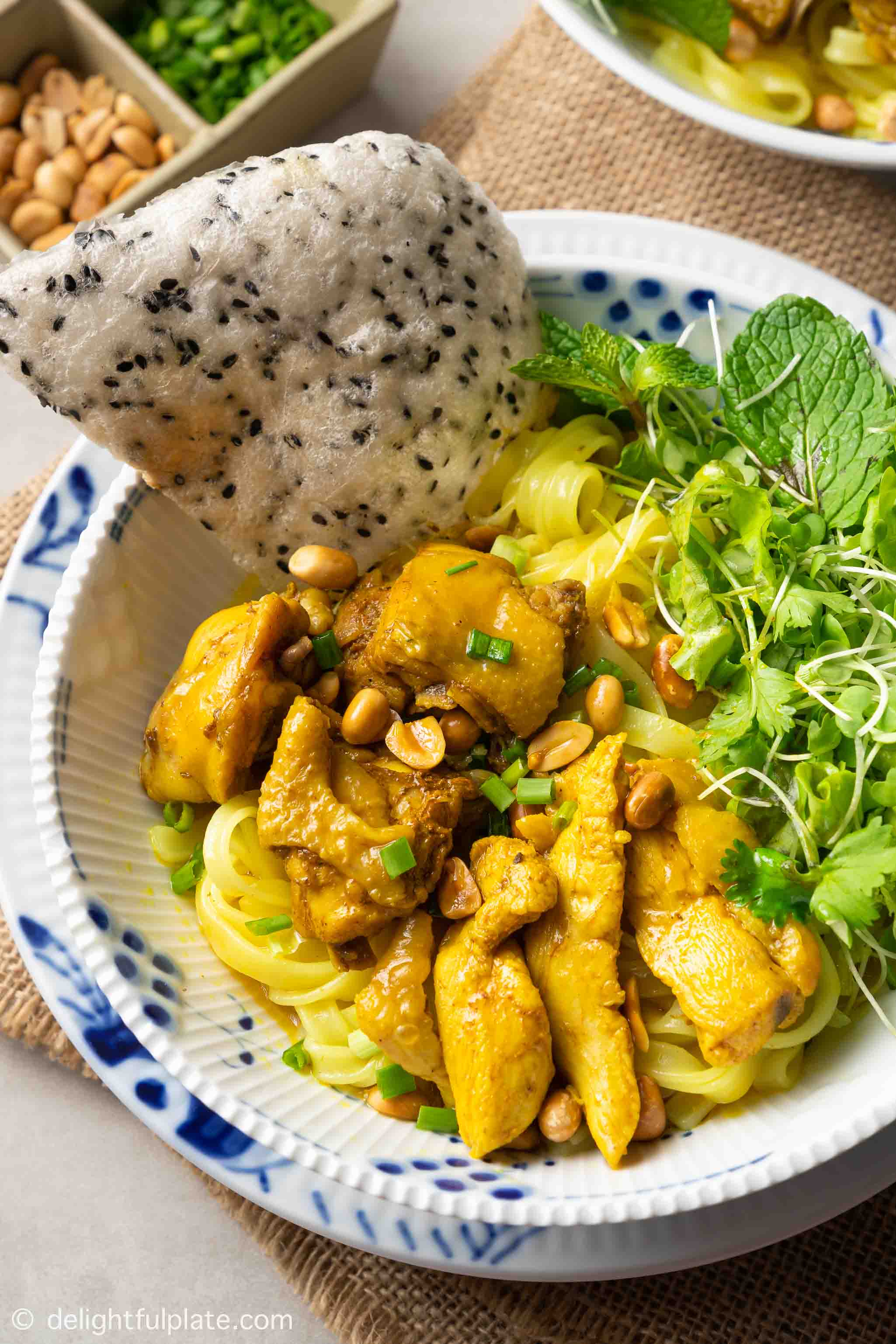
What is Mì Quảng?
Mi Quang is among the must-try dishes when one travels to the Danang – Hoi An area, besides Hoi An chicken rice. The area was once a busy port with merchants from all over Asia, such as Japan and China. Therefore, its regional cuisine is quite distinguishable from the rest of Vietnam, blending Viet flavors with those from Southeast and East Asia regions.
Although “mì” in Vietnamese often implies wheat flour noodles, Vietnamese Quang-style noodle actually uses rice noodles. The noodles can be either yellow or white. Placed on top will be a myriad of toppings, such as chicken, shrimp, pork, quail eggs and lettuce, microgreens, rice crackers, and roasted peanuts. A bowl of mi Quang is full of colors and textures.
One of the things that set this dish apart from other Vietnamese noodle dishes is the broth. It is often seasoned quite heavily, and barely enough broth to coat the noodles is added to the bowl. As a result, the broth never covers the noodles, but you can still use a spoon to eat it. So it’s not a noodle soup like pho, and not a dry noodle dish like Vietnamese beef noodle salad (bun bo xao) either.
The mi Quang recipe I’m sharing today (which was handed to me from my chef friend) is a classic version with chicken, called “mì Quảng gà“. I will also add some notes in case you want to make it with shrimp or pork.
Main Ingredients
Below are the main ingredients for mi Quang. Later in the post, there will be other sections about other toppings and accompaniments.
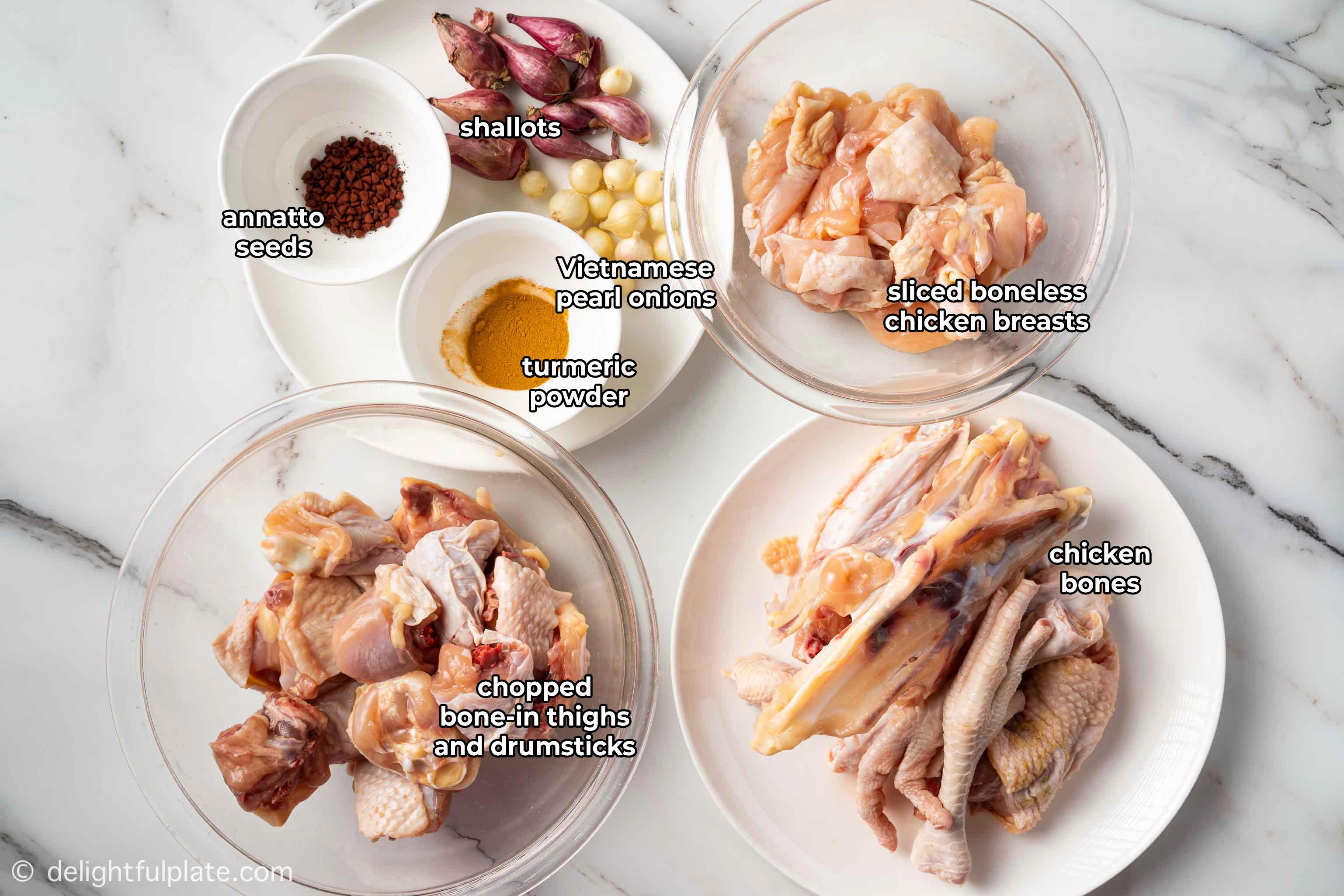
Chicken: you can choose to use a whole chicken, cut-up chicken parts with bones, or use a combination of boneless chicken for the toppings and chicken bones to make the broth.
When I use a whole chicken, I usually cut up the thighs and drumsticks into several pieces, debone the breasts then slice into strips, and use all the remaining bones for cooking the broth.
Shallots and Vietnamese pearl onions: a special ingredient in mi Quang is củ nén (Vietnamese pearl onions) which is a bit more pungent than shallots. When I cannot find it, I just use a lot more shallots to compensate.
Spices and seasonings: you will need turmeric powder, fish sauce, salt and pepper. To give the dish a beautiful color, Viet cooks also use some red annatto oil which is made from annatto seeds and vegetable oil. You may have seen how to make this oil in my bo kho (Vietnamese lemongrass beef stew) recipe. I personally think it is optional.

Rice noodles: the specific noodles for mi Quang may not be widely sold. An easy option is to use pho rice noodles instead. If you like the noodles to be yellow, simply add just a bit of turmeric powder to the water you will boil the noodles in.
Accompaniments
I recommend having the following accompaniments for Vietnamese Quang noodles. Feel free to omit what you can’t find, but the bold ones are strongly recommended:
- lettuce, microgreens, beansprouts, banana blossoms
- cilantro, scallion, Thai basil, mint
- roasted peanuts
- rice crackers (bánh đa mè)
I often buy these kinds of dry rice crackers (as in the image below), and then pop them in the microwave for probably a couple of minutes to puff them up. They can be found at Asian grocery stores.
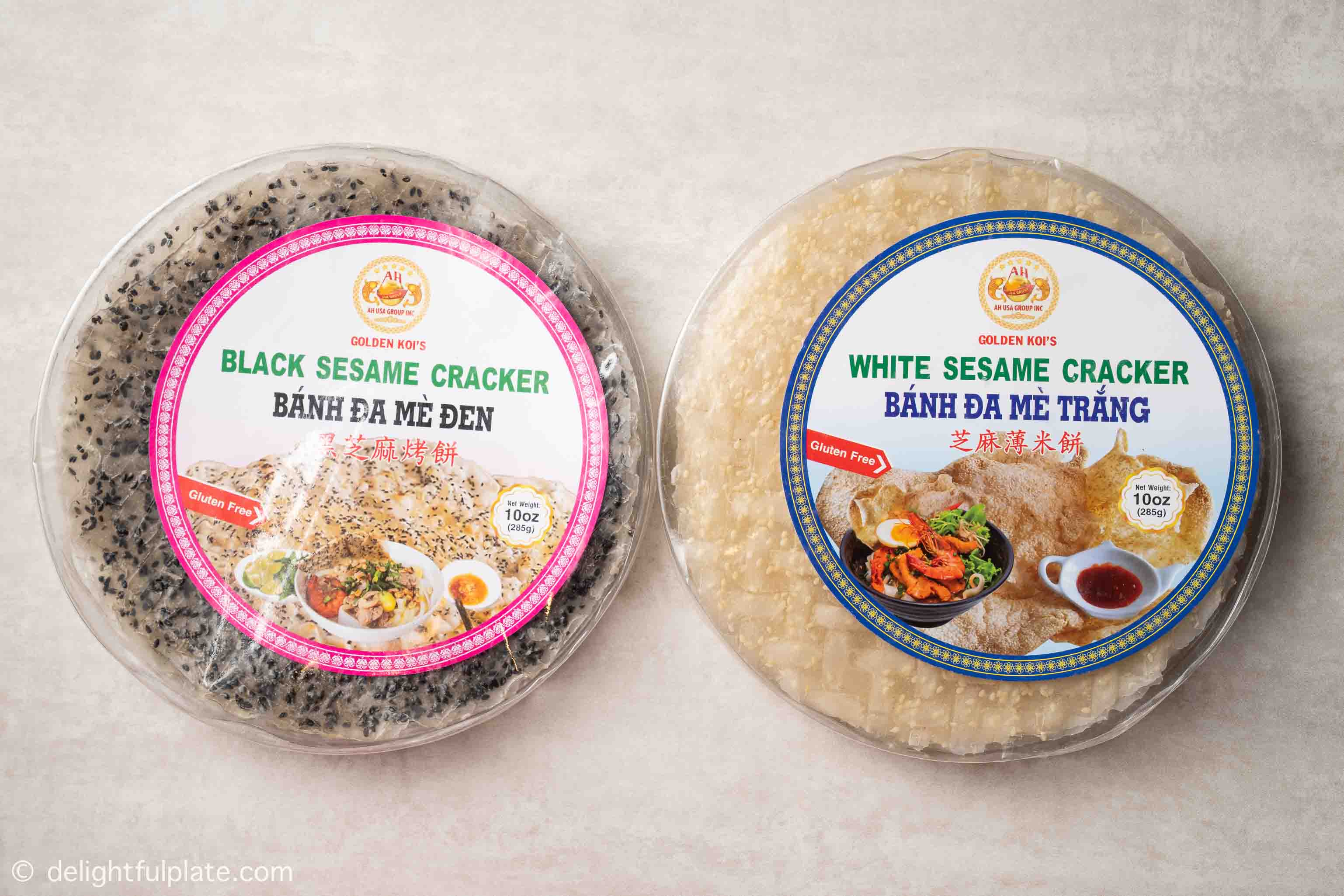
How to Make Mi Quang at Home
You may feel the list of ingredients and instructions look so long, but the dish is actually pretty straightforward to cook. One thing you may not like is the dish will require the use of several pots and pans. The two main cooking steps are making the broth and cooking the meat.
1️⃣ Cook the Broth
The base of the broth is just a simple chicken stock. First, parboil the chicken bones and then simmer the bones with ginger and charred shallots for over an hour. Near the end, we will season it with fish sauce and juice from cooking the chicken meat.

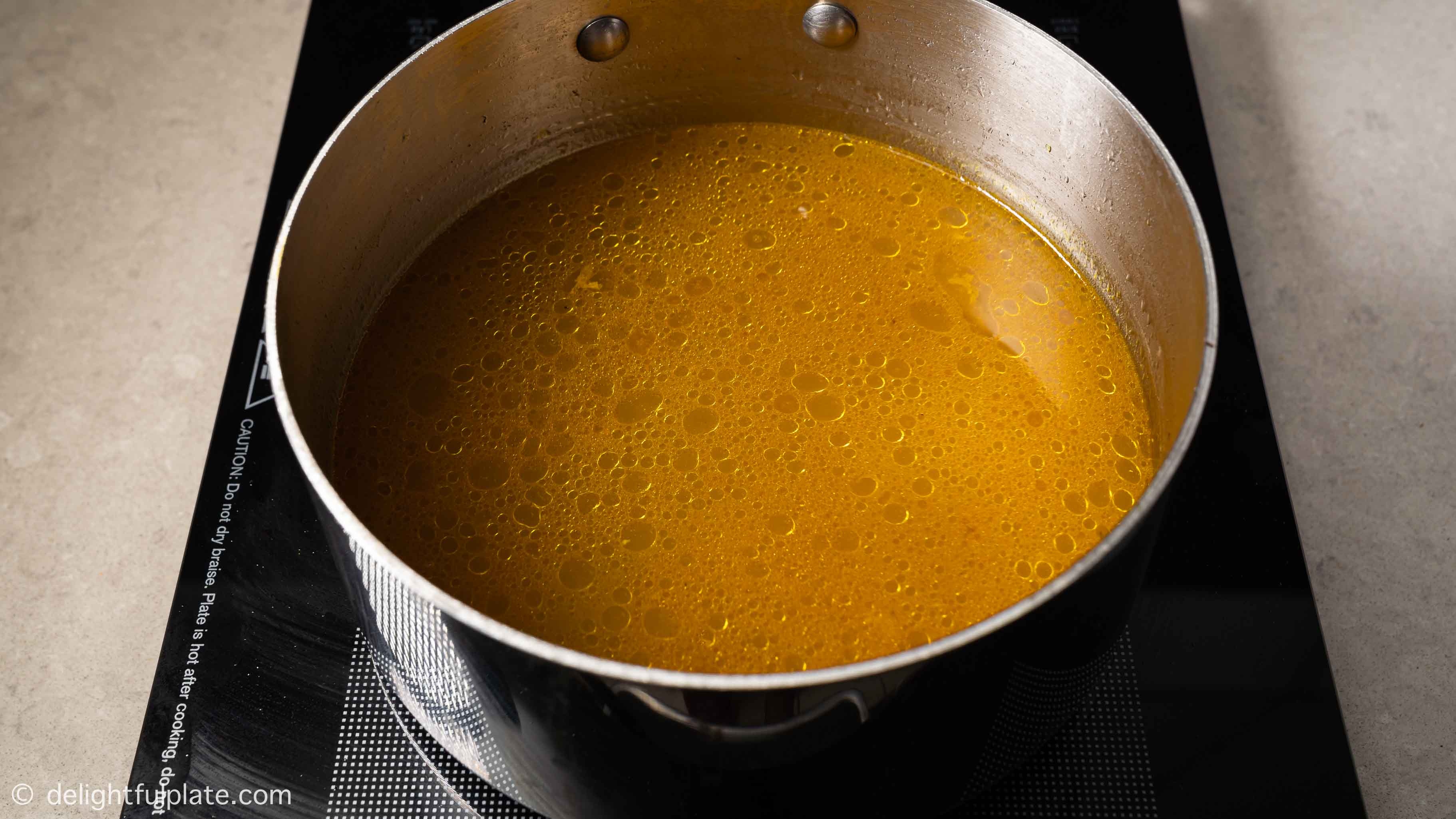
2️⃣ Cook the Meat
As mentioned above, I use boneless chicken breast strips and chopped thighs and drumsticks with bones for the toppings in this Vietnamese Quang-style chicken noodle. I cook them separately since they require different cooking time, but first, let’s marinate them with some turmeric powder and fish sauce.
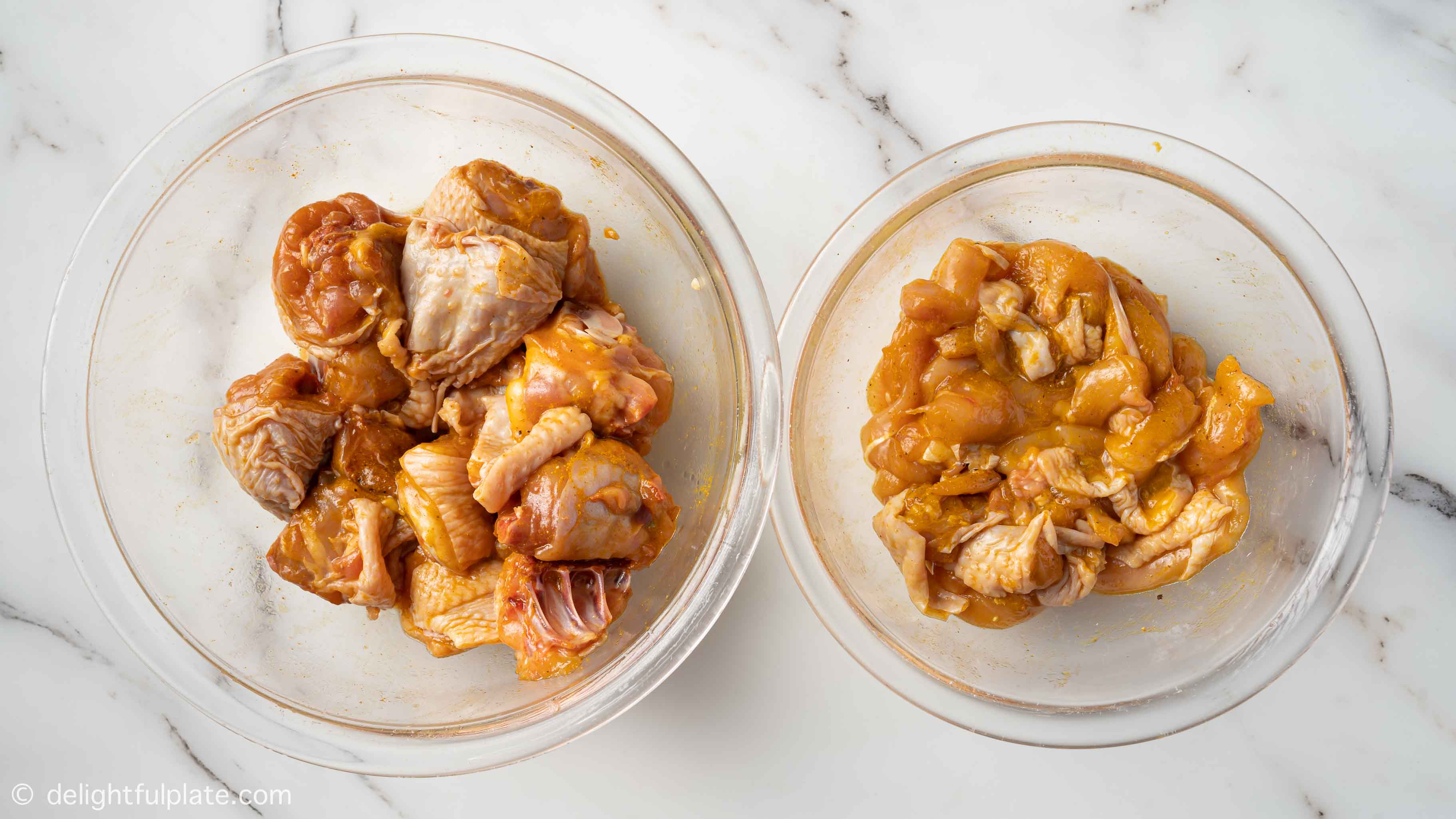
Either finely mince or pound the Vietnamese pearl onions (or shallots), then sauté until fragrant. Add the chicken breast strips and cook until no longer pink. Then add a bit of water and cook for another 10 minutes to firm up the meat and let it absorb the seasonings.
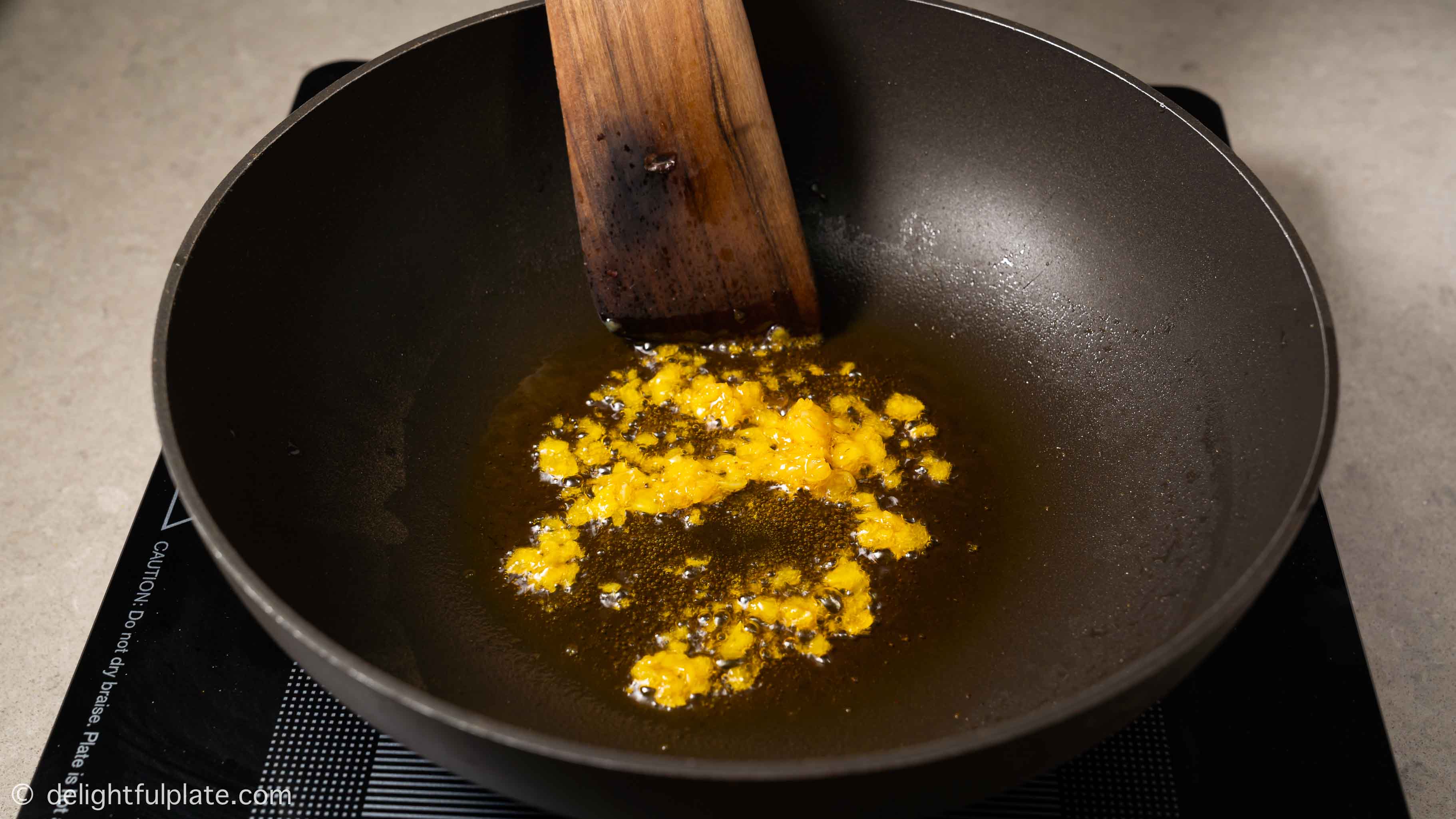
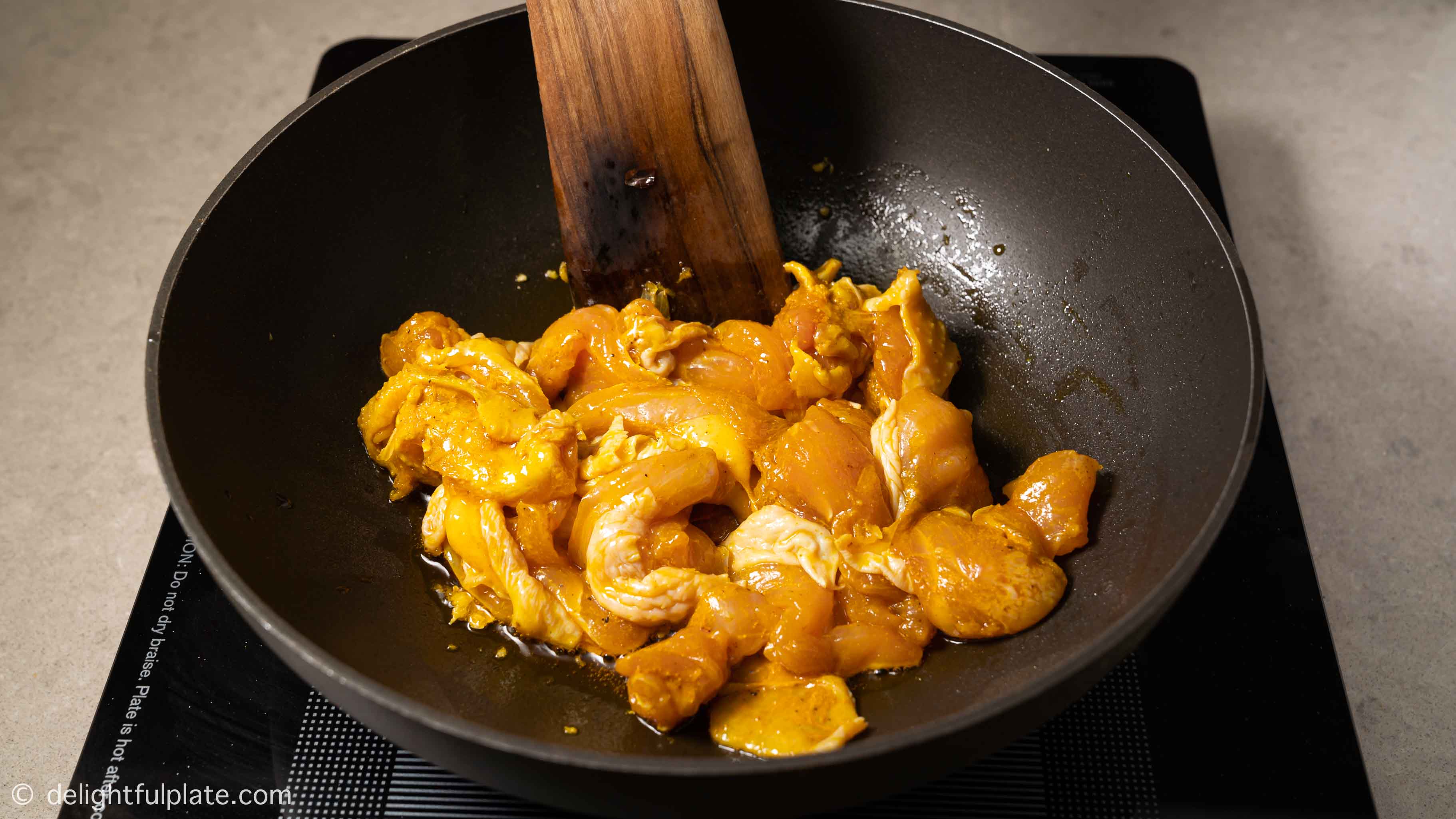

We will do the same for the chopped thighs and drumsticks. Cook until no longer pink, then add water and simmer for about half an hour. It’s almost like braising the meat.


And that’s all the main cooking steps. Of course, you may need to cook the noodles too if you use dried noodles, but that should be easy.
Other Toppings
Nowadays, Vietnamese Quang-style noodles may have a variety of cooked toppings besides chicken, such as:
- boiled eggs: usually quail eggs or chicken eggs
- different proteins: such as shrimp, pork ribs (or pork slices), fish, frog legs. If you decide to use a different protein, simply follow the same cooking method we use for chicken. Marinate, then sauté with pearl onions/shallots and braise until the protein is well-seasoned.
Here’s a bowl of mi Quang with shrimp and chicken I made a while ago.
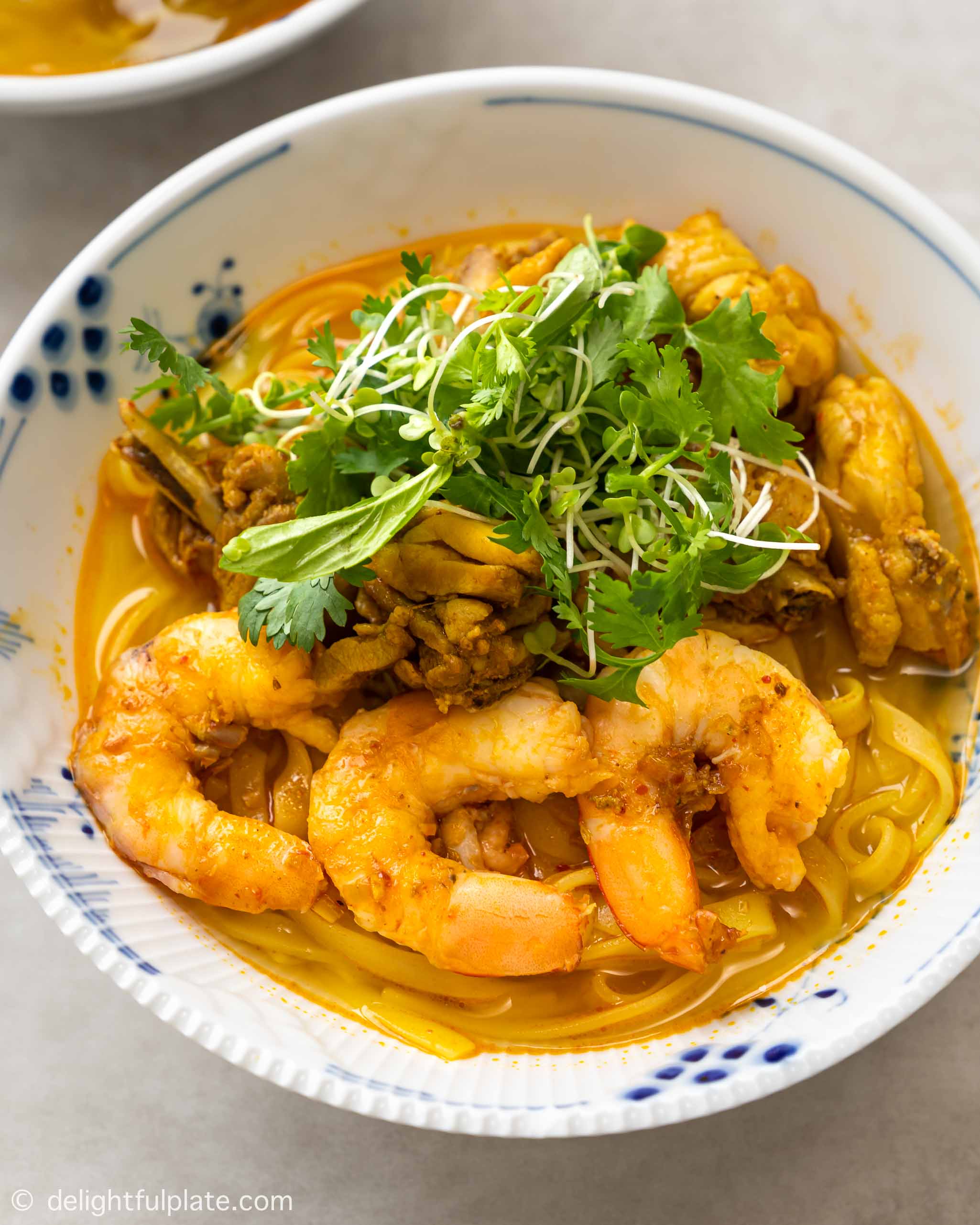
How to Serve Mi Quang
It’s easy to assemble a bowl of mi Quang.
- Add some cooked noodles to the bowl.
- Add the toppings, herbs and vegetables of your choice.
- Sprinkle scallions and roasted peanuts.
- Add the broth and make sure that the broth stays below the noodles. Having said that, if you prefer a more soupy mi Quang, feel free to go for it.

Serve the dish with some rice crackers, and add some lime juice or several slices of red chili if desired. Mi Quang shops often serve a small bowl of fish sauce with garlic and chili on the side as well.
Mi Quang is among one of my most favorite Vietnamese noodle dishes, and I hope it will become more well-known in the future. If you are ready for something new beyond beef pho and chicken pho, definitely give it a try. I look forward to hearing your feedback about this dish.

⭐️ I’d love to hear what you think about the dish, so please feel free to leave a comment and a rating if you have tried it. New recipes are added every week so let’s connect on Facebook, Youtube, Pinterest and Instagram for the latest updates. You can find my collection of Vietnamese recipes here.
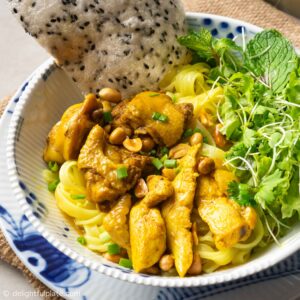
Mi Quang (Vietnamese Quang-style Noodle)
Ingredients
- 1 whole chicken (about 3 lbs/1.4kg; or use a combination of 1.25 lbs/600g chicken bones, 2 breasts and 2 bone-in legs)
- 6 cups water, divided (plus more to parboil the chicken bones)
- 1 small piece of ginger (about 1 inch/2.5cm long)
- 1 teaspoon salt
- 1 oz shallots (about 30g)
- 1/4 cup cooking oil
- 2 teaspoons red annatto seeds (about 6-7g)
- 1 1/4 teaspoons turmeric powder, divided
- 7-8 teaspoons fish sauce, divided
- black pepper
- 0.7 oz Vietnamese pearl onions, peeled and finely pounded or minced (called củ nén; or use 1.5 oz/42g more shallots)
To serve
- 4 servings rice noodles (about 1.5-2oz dried noodles per serving)
- roasted peanuts
- chopped scallion
- chopped cilantro
- soft green lettuce
- microgreens
- Asian rice crackers
- mint and/or Thai basil
Instructions
- If using a whole chicken, separate into chicken bones, boneless breasts and bone-in thighs and drumsticks. Slice the breasts into strips and use the poultry shears to cut thighs and drumsticks into smaller pieces.
- Bring a large pot with plenty of water to a boil, then add the chicken bones (with the wings and legs too, if any) and parboil for 1-2 minutes. Discard the liquid and give the bones a quick rinse. Clean the pot.
- Add 5 cups (1.2l) of water to the pot. Bring it to a simmer then add the chicken bones, ginger and 1 teaspoon salt. Let it come to a boil, then skim off the foam and return to a simmer.
- Place a skillet over medium heat and dry roast the shallots for several minutes until they are lightly charred and yield to the touch. Add the shallots to the stock pot, then cover and simmer for about 1 hour or up to 1.5 hours.
- Place a small pot over medium heat and add the oil. Place the annatto seeds in a heat-proofed bowl and once the oil is hot, pour it over the seeds. The oil should turn reddish and you can discard the seeds.
- Toss the chicken breast strips with ½ teaspoon turmeric powder, 2 teaspoons fish sauce, ¼ teaspoon black pepper and ½ tablespoon red annatto oil. Set aside to marinate for 20-30 minutes.
- Toss the chopped thighs and drumsticks with the remaining turmeric powder, 4 teaspoons fish sauce, ¼ teaspoon black pepper and 1 tablespoon red annatto oil. Set aside to marinate for 45-60 minutes.
- Once the marinating time for the chicken breast is over, place a sauté pan over medium heat. Heat 1 tablespoon red annatto oil, then add ⅓ of the pounded Vietnamese pearl onions and cook for a few seconds until fragrant.
- Add the chicken breasts and sauté until the outside is no longer pink. Add ¼ cup (40ml) water into the pan and braise for about 10 minutes until the meat firms up and absorbs the seasonings. Transfer the meat along with any cooking juice to a clean bowl.
- Heat the remaining red annatto oil and sauté the remaining pounded Vietnamese pearl onions until fragrant. Add the chopped thighs and drumsticks and sauté until the outside is no longer pink. Then add 3/4 cup (180ml) water into the pan and braise for about 20 minutes (up to 30 minutes) until the meat firms up and absorbs the seasonings. Transfer the meat along with half of the cooking juice to a clean bowl. Pour the remaining cooking juice into the stock pot.
- The broth should also be ready by now. Season the broth with 1-2 teaspoons fish sauce or to taste. The broth for mi Quang is usually heavily-seasoned.
Assemble the Dish
- Prepare the noodles according to package instructions. If you prefer the noodles to be yellow, add a pinch of turmeric powder to the cooking water before adding the noodles.
- Divide noodles into serving bowls. Top the noodles with cooked chicken breasts, thighs and drumsticks pieces. Also divide the cooking juice into serving bowls.
- Add some lettuce, micro greens and fresh herbs to the bowls. Sprinkle chopped scallions and roasted peanuts on top. Pour broth into serving bowls. Add as much broth as desired, but generally the broth should not fully cover the noodles.
- Serve with rice crackers and if desired, a small bowl of fish sauce with some slices of red chili pepper on the side.
Notes
- boiled eggs: usually quail eggs or chicken eggs
- different proteins: such as shrimp, pork ribs (or pork slices), fish, frog legs. If you decide to use any of these different proteins, simply follow the same cooking method we use for chicken. Marinate, then sauté with pearl onions/shallots and braise until the protein is well-seasoned.


